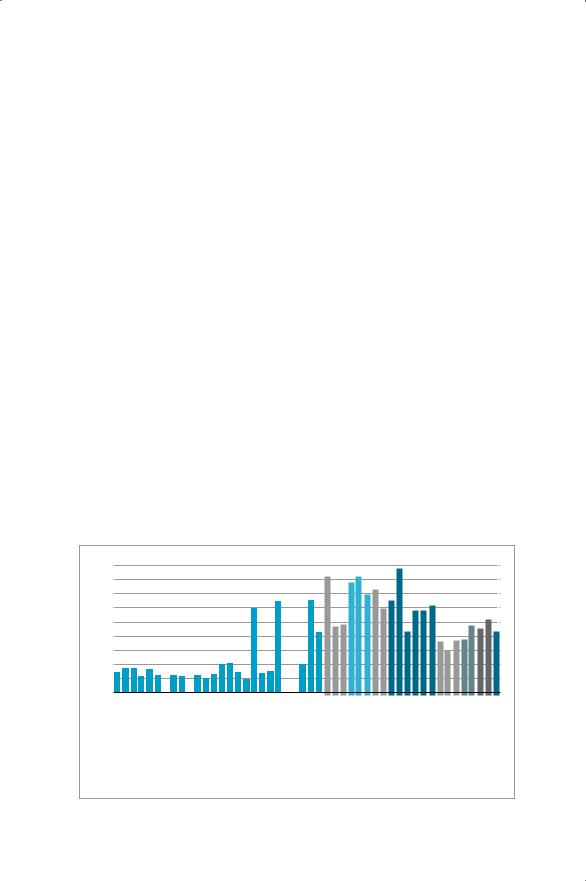
NPAC 2014 Proceedings_final
.pdf
64 |
Patterns of Arctic Investment |
activity in the country, and thereby on its economic development prospects. Not surprisingly, according to the “Energy Strategy of the Russian Federation up to 2030,”2 which is the basic document setting out Russian energy policy, one of the most important strategic initiatives of the State in the energy industry is “Exploration of the Arctic continental shelf and northern regions (which should help stabilize oil and gas production after a possible downturn in the traditional oil-producing areas of Western Siberia
in 2015-2030).”
Despite all declarations and intentions, however, the fate of the Russia Arctic oil and gas projects is not clear. Some of them have been postponed for an indefinite period (e.g. Shtokman), while others have taken several decades longer than expected for their implementation (e.g. Prirazlomnoe, the Yamal mega-project).
RUSSIAN ARCTIC OIL AND GAS INVESTMENT PROJECTS
The magnitude of investment in the Russian Arctic projects is impressive: 10 billion USD for the Kharyaga oil field, 5 billion USD for the Trebs and Titov oil fields, 6 billion USD for the Prirazlomnoye field, 75-130 billion USD for the Yamal mega-project, 30 billion USD for Yamal-LNG, 3 billion USD for the Novoportovskoye and Messoyakha fields development – totaling 130-185 billion USD. These are probably the most costly and largest projects in the entire Russian energy sector, with long lead times, high risks and an unclear period of investment return. Most of these investments were made with significant delays compared to the initial plans and schedules, which seems to be a common trend in this complicated and challenging area.
Several of these projects have huge infrastructure components, which is understandable: operators have to develop their production in remote frontier areas where no infrastructure exists at all, so once they decide to engage in a project, they have also to take the responsibility to build all the infrastructure necessary for its implementation. Prime examples are the Varandey terminal, a railway within the Yamal mega-project, and the Port of Sabetta.
The major investors in Russian Arctic oil and gas projects are large national state-controlled companies such as Gazprom and Rosneft,

Commentaries |
65 |
influential private companies (like Novatek) and a few foreign majors cooperating with the state giants, such as Total, and until recently ExxonMobil, Statoil and ENI (See Table I-1).
Table I-1. Key offshore exploration projects linking Gazprom and Rosneft with foreign companies
Foreign |
Number |
Offshore blocks |
Comment/structure of the deal |
Partner |
of license |
|
|
|
areas |
|
|
|
|
|
|
|
|
Gazprom |
|
|
|
|
|
Total |
1 |
Shtokman |
Discovered in 1988 and located about 600 km |
|
|
|
offshore from Murmansk, the Shtokman gas |
|
|
|
and condensate field is believed to hold 3.8 tcm |
|
|
|
of gas and 53.4 Mt of gas condensate. In 2013, |
|
|
|
the project’s development was postponed to after |
|
|
|
2020 or even later, as initial partners Gazprom, |
|
|
|
Total and Statoil didn’t make a final investment |
|
|
|
decision over challenges related to project |
|
|
|
design and costs. Statoil then left the project. |
|
|
|
According to Gazprom, field development would |
|
|
|
be divided into three phases. Phase 1 and Phase |
|
|
|
2 would allow for respective annual production |
|
|
|
of 23.7 and 47.4 bcm of gas. The field is to reach |
|
|
|
its design capacity of 71.1 bcm /year through |
|
|
|
implementing Phase 3 at a later stage.3 |
|
|
|
|
|
|
Rosneft |
|
|
|
|
|
ExxonMobil |
11 |
The license blocks |
In return for obtaining the right to conduct |
|
|
include Severo- |
exploration activities in these areas (agreements |
|
|
Vrangelevsky-1, |
have different legal status and validity, though, at |
|
|
Severo- |
this stage and may not all be firm), ExxonMobil |
|
|
Vrangelevsky-2 and |
envisions that Neftegaz America Shelf LP |
|
|
Yuzhno-Chukotsky |
(Neftegaz), an indirect independent subsidiary of |
|
|
blocks in Chukchi |
Rosneft, acquires a 30% interest in 20 deep-water |
|
|
Sea, Ust’ Oleneksky, |
exploration blocks in the Gulf of Mexico held by |
|
|
Ust’ Lensky |
ExxonMobil. In a separate Heads of Agreement, |
|
|
and Anisinsko- |
Rosneft (or its affiliate) have an opportunity to |
|
|
Novosibirsky blocks |
acquire a 25% interest in the Point Thomson |
|
|
in Laptev Sea and |
Unit, which covers the project of developing |
|
|
Severo-Karsky block |
a remote natural gas and condensate field on |
|
|
in the Kara Sea |
Alaska’s North Slope. It is estimated that Point |
|
|
|
Thomson contains approximately 25% of the |
|
|
|
known gas resource base in Alaska’s North Slope. |
Statoil |
4 |
The Kashevarovsky, |
|
|
Lisyansky and |
|
|
Magadan-1 licenses |
|
|
are in the Sea of |
|
|
Okhotsk north of |
|
|
Sakhalin Island, |
|
|
and the Perseevsky |
|
|
licence is in the |
|
|
Central Barents Sea. |
The license requirements include drilling of six exploration wells in the period from 2016 to 2021. Statoil will carry the expenses of exploration activities required to determine the
commercial value of the licenses. The three Arctic license areas cover a territory of 79,000 km2.

66 |
Patterns of Arctic Investment |
Table I-1. Key offshore exploration projects linking Gazprom and Rosneft with foreign companies (continued)
Foreign |
Number Offshore blocks |
Comment/structure of the deal |
Partner |
of license |
|
|
areas |
|
|
|
|
ENI |
3 |
The Fedynsky block |
|
|
(38,000 km2) is |
|
|
located in the ice- |
|
|
free part of the |
Barents Sea. The
Central Barents block (16, 000 km2) borders Fedynsky from the North; and the Western Chernomorsky block in the Black Sea.
Eni has reportedly started 2D seismic surveys and a first well.
Inpex |
2 |
Offshore blocks |
|
|
Magadan-2 and |
|
|
Magadan-3 in the |
|
|
Russian section of |
|
|
the Sea of Okhotsk. |
An MOU was signed in May 2013: INPEX was granted exclusive rights to negotiate toward a final agreement, expected by the end of 2013. INPEX would reimburse the development expenses for the licensed blocks incurred by Rosneft, as well as 33.3% of a one-off payment made by the Russian company during the course of license acquisition. Furthermore, the agreement provides for non-recurrent bonuses to be paid by INPEX to Rosneft for each commercial oil and gas discovery proportionally with its stake in the project. Both firms plan to set up a joint venture to explore the offshore blocks.
CNPC |
3 |
These blocks |
Preliminary agreements were signed in March |
|
|
are located in |
2013. Some of these areas have never been |
|
|
the Barents and |
explored before and are thus quite unknown. |
|
|
Pechora Seas (West |
|
|
|
Prinovozemelsky, |
|
|
|
Yuzhno-Russky |
|
|
|
and Medynsko- |
|
|
|
Varandeisky) as |
|
|
|
well as onshore |
|
|
|
blocks in the Irkutsk |
|
|
|
Region, Krasnoyarsk |
|
|
|
Territory and |
|
|
|
YNAA. |
|
Petrovietnam |
|
Blocks would |
The parties also signed an MOU over Rosneft’s |
|
|
be located in the |
potential acquisition of a stake in the production |
|
|
Pechora Sea. |
sharing agreement (PSA) for Block 15-1/05 |
|
|
|
offshore Vietnam. |
Source: IEA Russian Energy Policy Review 2014.
While a Russian company typically holds the license, these agreements generally involve a shareholder agreement of 33.33% for the foreign

Commentaries |
67 |
company in the joint venture, and a commitment by the foreign company to finance exploration activities in line with license obligations and to develop joint technologies. IOCs teaming up with these two Russian statecontrolled companies have to operate on a risk-service basis and cannot own any equity, i.e., the license and reserves. Indeed, under the current schemes developed for exploration works in the Arctic shelf, they are minority shareholders in foreign registered joint ventures in which Russian state companies Rosneft and Gazprom are majority shareholders. Foreign companies have insisted that foreign joint ventures be established to benefit from greater legal security and have established complex contractual frameworks to overcome gaps and uncertainties in the Russian legislation. As such, there is room to further clarify and make more precise the Russian legislation and regulatory framework to facilitate these partnerships between foreign and Russian companies.
Should gas or oil finds be made and the decision taken to move to a production phase, the Russian partner would generally reimburse its share of exploration costs. These agreements also involve a reciprocal equity agreement for some projects that these IOCs develop abroad, so far in North America, North Africa and the North Sea, allowing Rosneft to gain expertise and develop internationally, while also giving foreign partners an opportunity to gauge this cooperation. Such asset-swap type agreements are supported by the Russian government, and others could follow.
Rosneft and ExxonMobil started first exploratory drillings in August 2014 in the Kara Sea, but with the rapid deterioration of the relationship between Russia and the West and the “war of sanctions,” they had to stop the operations and suspend a well, losing significant investments made. In the current geopolitical climate, the future involvement of the international majors in the Russian Arctic is becoming increasingly questionable, as all technologies for Arctic offshore drilling and production are on the sanction lists of the United States and the European Union.
The number of smaller, independent Russian companies active in this area is negligible. Huge costs, together with the law on “strategic fields” in significantly limit the number of potential participants in the Arctic development “business of the big guys.” It is difficult to disagree with Kryukov that the institutional environment for Arctic oil and gas projects in Russia during the last two decades has been contradictory and ambiguous.
In the future, the potential growth areas for investment in the Russian Arctic are first the Yamal Peninsula, where the major infrastructure has

68 |
Patterns of Arctic Investment |
already been created, and the Kara Sea (with all Rosneft exploratory activities). But these investments are at the moment also significantly limited by the financial sanctions.
The situation is quite different for oil and for gas: Gazprom already produces Yamal gas (at the Bovanenkovo gas field on Yamal, though at rather small volumes due to a lack of demand), and the transportation system has been built, so there are no serious obstacles for further expansion of gas production in this area. Conversely, the new Arctic oil projects, led by Rosneft, are mainly focused on exploration. Here the uncertainty and risks are high. The uncertainty is associated with the geology, as many geologists predict that the Kara Sea might hold not oil but gas deposits, and that the lifting costs are going to be high. According to different estimates, even if the exploratory activity is successful and if large oil reserves are discovered, Russia would be able to start producing them no earlier than in one decade, reaching about 10-15 million tonnes per annum by 2025-2030 in the most optimistic case. The IEA’s World Energy Outlook 2013 projection of Russian Arctic oil production is also modest – just 0.11 mb/d, or 1.1% of total production by 2035.
As Arctic projects are extremely expensive, taxation will be one of the key factors defining their success. The government has already provided a number of fiscal incentives to foster exploration activities in the offshore Arctic, including unlimited MET exemptions, export tax exemption (yet limited in time, for example on 250 bcm of gas for the Yamal LNG project and up until 2042 for Arctic resources), and property tax and amortization holidays. Yet more incentives are likely to be necessary in order to attain higher investment levels given the very high anticipated production costs.
Resource access and the number of players is the key factor in the success of Russian Arctic offshore development. So far, only companies with over 50% state ownership and more than five years of experience in marine exploration are allowed to participate in auctions for licences on the continental shelf in Russia’s Arctic regions. This means that no private companies are given access to these areas, in spite of Lukoil, for example, having extensive offshore experience (in the Korchanginskoe field in the Caspian Sea for example) and conducting exploration activities in the Norwegian Barents Sea. Consequently, 80% of licences have already been given to Gazprom and Rosneft. However, even with partnerships with foreign companies there will be limits to how much they can handle.
Clear and strict environmental policy is also an essential condition for

Commentaries |
69 |
the Russian Arctic projects’ success. Developing possible Arctic resources will bring key environmental and technological challenges given the harsh environment, with offshore drilling from platforms surrounded by ice and low temperatures. Any accident could have a devastating impact on sensitive Arctic ecosystems. Any misstep by industry could postpone Arctic resource development for decades. Thus is why developing a robust security and environmental protection framework is key along with ensuring that the most advanced and relevant technologies are employed.
Another issue that is becoming critical for the future of the Russian Arctic in the current geopolitical and economic situation is the ability of the companies to attract credit finance, which implies that banks are confident that risks, especially those taken by foreign partners, are reasonable and addressed in the contractual and regulatory framework, and there are no restrictions or sanctions. Now, it seems that only companies with internal financial resources, loans from Russian financial institutions and also from Chinese banks will be the major sources of financing for the Russian Arctic projects.
Access to offshore drilling technologies and LNG equipment is also important. Without Western technologies, Russia would have to postpone the development of the projects until domestic Russian technologies are developed. The state would also need to ensure the development of a vibrant and competitive service industry in Russia capable of providing state-of-the art drilling technologies at reasonable and competitive prices.
Further exploration and research activity is needed in the Arctic in the coming decades in order to prepare for hydrocarbon production in a safe, sustainable and commercially efficient way, and it seems that the oil and gas companies still have a long way to go in ensuring that resource extraction can be viable economically and occur safely while protecting sensitive Arctic ecosystems.
Notes
1.Whether the Nadym-Pur-Taz area in Yamal-Nenetz Okrug is included or not mainly depends on the definition.
2.The last edition was accepted in 2009 and currently the new, updated Energy Strategy up to 2035 is in development.
3.http://www.gazprom.com/about/production/projects/deposits/shp/

70 |
Patterns of Arctic Investment |
Commentary
Nam Yll Kim
ARCTIC RESOURCE INVESTMENT RISKS AND LNG PROJECTS
Status of Arctic Area Resources
The Arctic Ocean is currently thought to have 22% of the world’s undiscovered energy resources, estimated to be composed of 13% oil (90 BB), 30% gas (1,679 Tcf) and 20% NGL (44 BB).1 About 60% of these resources are concentrated in Russia.
Arctic Resource Investment Risks and Cost Comparisons among Transportation Modes
There are lots of risks to confront for an Arctic energyresources investment project. The first would be the geological risk. The fact that the estimated value of resources announced by the USGS is based on an educated guess and not based on thorough, widespread exploratory drilling must be noted. The second risk comes from harsh weather conditions. Because of
300,000.00 |
|
|
|
|
|
|
*.#)& |
|
|
|
MMBOE |
|
|
|
|
|
|
|
|
|
|
|
|||
250,000.00 |
|
|
|
|
|
|
|
|
|
|
||
|
|
|
|
|
|
|
|
|
|
|
|
|
200,000.00 |
|
|
|
|
|
|
|
|
|
|
|
|
150,000.00 |
|
|
|
|
|
|
|
|
|
|
|
|
100,000.00 |
|
|
|
|
|
|
|
|
|
|
|
&,#+- |
|
|
|
|
|
|
|
|
|
|
|
|
|
50,000.00 |
|
)#,+ |
-#)' |
|
|
|
|
|
|
*#%- |
|
|
|
|
|
|
,- |
|
'#-, |
|
|||||
|
|
|
|
|
|
|
|
|||||
|
|
|
|
|
|
|
|
|
|
|
||
0.00 |
|
|
|
|
|
|
|
|
|
|
|
|
|
Canada |
|
|
|
|
|
|
|
|
|
|
|
|
|
Greenland |
Norway |
Russia |
Rissia/Norway |
Russia/USA |
USA |
|||||
Figure I-2. Arctic resources by geography

|
|
Commentaries |
71 |
|
|
|
|
|
RUSSIA |
28 BBO |
RUSSIA |
Sea of |
|
||
|
|
||
|
1,168 TCFG |
|
|
Okhotsk |
|
|
|
|
31 BBNGL |
|
|
|
|
|
???? |
Arctic |
Circle |
|
||
|
|
|
Bering Sea |
|
|
UNITED
STATES (Alaska)
30 BBO
228 TCFG
6 BBNGL
CANADA
Kare Sea
Arctic Ocean
+
North Pok
FINLAND
NORWAY |
SWEDEN |
|
|
||
3.5 BBO |
|
|
59 TCFG |
Arctic |
|
Greenland 78 BBNGL |
||
Sea |
|
Circle |
|
|
|
18 BBO |
ICELAND |
|
148 TCFG |
||
|
||
10 BBNGL |
|
|
GREENLAND |
|
|
|
North |
|
|
Atlantic |
|
|
Ocean |
North Paci c |
11 BBO |
|
||
Ocean |
|
|||
66 TCFG |
Labredor |
|||
|
|
|||
|
|
75 BBNGL |
||
|
|
Sea |
||
|
Northwest Passage |
BBO: billion barrels of oil |
Sources: U.S. Geological Survey, 2008; |
|
|
||||
|
Northern Sea Route |
TCFG: trillion cubic feet of gas |
United States Coast Guard Arctic Strategy, May 2013 |
|
|
||||
|
|
BBNGL: billion barrels of natural gas liquids |
|
|
Figure I-3. Estimated undiscovered Arctic oil and gas and potential trade routes
frequent icy storms and low temperatures, the drilling window term is very short (summer time from June to October), and the drilling equipment may be polluted. The third is regulatory risk. Since the Macondo accident in the U.S. Gulf of Mexico in 2010, governments around the world have strengthened safety and environmental regulations. This has brought about increased costs of complying with the regulations, along with the inflation of insurance costs, which is a big burden for smaller resource development corporations. The fourth risk is environmental sensitivities. In order to develop resources in the Arctic, operators must adapt to ever-changing conditions of the Arctic. The fifth risk is infrastructure challenges. It is difficult in the first place to build and operate infrastructure safely in the Arctic, but transporting the resources produced in the Arctic safely to the market is another problem. And out of these risks, whether a transportation infrastructure exists or not greatly affects the investment cost for resource

72 |
Patterns of Arctic Investment |
development.
Although it is difficult to treat it as a risk indigenous to the Arctic, political risk exists as well. Due to the current situation in Ukraine, sanctions on the Russian energy sector have been imposed by the United States and the European Union. The banning of all exports of Arctic offshore drilling rigs for oil has been applied against Russia. Yamal LNG (Novatek 60%, Total 20%, CNPC 20%) is unlikely to be impacted by the technology sanction, and Yamal LNG is not a sanctioned entity, but its financing options will be restricted, increasing its cost of capital. In addition, Rosneft and ExxonMobil have recently expanded their strategic collaborative relationship for Arctic resource development. But western sanctions have frozen this arrangement as well.
The majority of gas development in the Arctic will take the form of LNG investment projects. The reason for this comes from the long transportation distance between the Asia-Pacific region, which is thought to possess most of the world’s gas demand increase,2 and the Arctic. Also, because the form of LNG is favorable for long-distance shipping, gas developed in the Arctic area will most likely be processed into LNG instead of PNG. The picture below explains this situation clearly.
As the picture shows, as distance increases, (1) the benefits of LNG transportation surpass those of gas pipelines, (2) LNG ships are more flexible when it comes to shipping out to its destination, unlike PNG with designated destinations, and (3) long-distance shipping requires passing
Dollars per MBtu
7
6
5
4
3
2
1
Gas pipelines
LNG
Onshore |
Crude |
crude line |
oil tanker |
Coal by ship
|
|
|
|
|
|
|
0 |
5,000 |
10,000 |
15,000 |
|||
|
|
|
|
|
kilometres |
|
Note: The main determinants of gas transportation costs within the ranges indicated are: for pipelines, the diameter of the pipe and the terrain to be crossed; and for LNG, the initial costs of liquefaction capacity. Source: Adapted from Jensen (2012).
Figure I-4. Cost comparison among transportation modes

Commentaries |
73 |
through multiple national boundaries, and LNG tankers are better suited for avoiding this trouble.
Economics of Russian Arctic LNG Projects
Arctic resource development projects have a high cost business structure. Because of the hard development conditions (weather, frozen ground, ice flows and lack of infrastructure), the development cost is greater than that of LNG projects involving North America’s shale gas resources or those in East Africa. And the additional costs (charges for using icebreakers or specialized transport vessels, establishment of transportation facilities in frozen ground areas) regarding resource transportation are also likely to be high, no less than the development costs.
In December 2013, Novatek and Total announced a final investment decision on a three-train, 16.5 mmtpa, Yamal LNG project in the Arctic Circle. The first LNG shipment is scheduled for 2017. Novatek, Russia’s largest independent gas producer, has a 60% equity, while Total and more recently CNPC have each acquired 20% in the project. Yamal LNG will be the first LNG project in Russia since the Sakhalin-2 investment decision in 2003. The project has received heavy government backing in the form of significant tax breaks, support in gas sales negotiations, liberalizing of LNG exports and funding for the construction and dredging of Sabetta Port. So
18
16
14
12
10
8
6
4
2
0
Leviathan FLNG
Tanzania LNG
Mozambique LNG
Vladivostok LNG
Yamal LNG
Tangguh Phase 2
MLNG Train 9
Abadi
Pacic Northwest LNG
Kitimat LNG
LNG Canada
Savine Pass Phase1
Petronas FLNG1
Prelude FLNG
Ichthys
Wheatstone LNG
APLNG
GLNG
QCLNG
PNG LNG
DS LNG
Gorgon
Angola LNG
Pluto
Pefu LNG
RL 3
Qatargas 2
Sakhalin 2
Yemen LNG
Tangguh Phase 1
Snohvit
EG LNG
Darwin
Damietta
ELNG 1
MLNG Tiga
Qalhat LNG
Atlantic LNG 4
RasGas ll
Atlantic LNG 2&3
OLNG
RasGasl
Atlantic LNG 1
NLNG Base
Qatargas-1
North West Shelf
MLNG Dua
MLNG
Source : Wood Mac 2013.
Figure I-5. FOB break-even cost at 12% IRR ($MMBtu)
